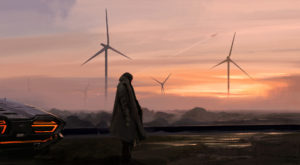Nuclear power is often described as “the double-edged sword of science”, reflecting the fact that it can be used for both useful and peaceful purposes as well as deadly and destructive ends. This has never been truer than today. On the one hand, fission technology, in the form of nuclear warfare, still holds the potential to spell the end of mankind; on the other, in the form of abundant carbon-free nuclear energy, it could hold the key to civilisation’s survival.
The past year has brought the dualistic nature of nuclear energy into stark relief: the Ukraine conflict — and the proxy war between the West and Russia playing out in its background — raised again the terrifying spectre of a nuclear conflict between the world’s major superpowers. At the same time, it has renewed interest in atomic energy, as policymakers grapple with an energy “polycrisis” that has profound economic, geopolitical and environmental ramifications.
The period between the mid-Sixties and early Eighties was the golden age of nuclear power: hundreds of reactors were built globally, at a rate of 20-40 new plants a year. Despite growing opposition from environmental groups (often funded by the oil industry) and the general public, largely due to the blurring of nuclear power and nuclear weapons in the latter’s mind, this period was nonetheless characterised by widespread optimism about the potential for nuclear energy to usher in a post-fossil future.
Then, in 1986, the Chernobyl disaster changed everything, instilling in us a comprehensible — but irrational — fear of atomic energy. Nuclear power plant construction plunged, especially in Europe and the US. The incident at Fukushima, in 2011, reinforced those fears, leading not only Japan but also countries such as Germany to begin a phase-out of nuclear energy. With the exception of a few nations — Sweden, France, Finland — investment in nuclear all but ground to a halt in the West.
As of mid-2022, 411 reactors were operating in 33 countries, seven fewer than 1989, and 27 below the 2002 peak of 438. The year before, nuclear energy’s share of global commercial gross electricity generation sunk to 9.8% — the lowest in four decades. Between 2002 and 2021, 98 plants were built (while 105 closed), but more than half of the new constructions took place in a single country: China. Meanwhile, outside of China, there has been a net decline of 57 units over the past 20 years.
Until not too long ago, the fate of nuclear energy seemed to be sealed. Western countries prided themselves in steadily decreasing their CO2 emissions, while increasing their share of renewables, convincing themselves that they could slowly wean themselves off fossil fuels without resorting to nuclear. The reality was quite different. In virtually every country that shut down its nuclear power plants following the post-Fukushima panic, clean energy was replaced mostly with fossil fuels, which polluted the air with their particulates and toxins, increasing cancer and emphysema in the population. Researchers in Germany have estimated the deaths from this switch to be in the thousands each year, or easily more than 10,000 over the past decade.
Moreover, to the extent that Western nations have shifted most of their manufacturing to Asia over the past two decades, they have simply “outsourced” their climate pollution to those countries. The truth is that the global energy mix has hardly changed over the past 35 years, with the world remaining as dependent as ever on fossil fuels. And the past year has awoken Western countries to this in the most painful way possible. As the invasion of Ukraine forced European countries to turn to coal and even fracking in a desperate attempt to replace Russian gas supplies, we were reminded of how reliant we still are on fossil fuels to keep the lights on, our homes heated and our factories humming. Indeed, global use of coal hit an all-time high in 2022, and is expected to peak in 2023. The picture is darker still across emerging markets and developing economies, where soaring energy prices have resulted in shortages, blackouts, protests, and extreme poverty.
But there is a silver lining to the energy crisis. Recent months have marked a dramatic recovery for the prospects of nuclear energy across the developed world. Last year, Boris Johnson launched an ambitious plan to build eight new reactors and 16 next-generation small modular reactors (SMRs), in order to triple domestic nuclear capacity to 24 gigawatts by 2050 — 25% of the UK’s projected electricity demand. Currently, the UK’s ageing nuclear fleet makes up around 15% of the country’s energy generation, but the remaining five power plants are set to be shut down by the middle of the next decade. More recently, Rishi Sunak and Emmanuel Macron pledged “ambitious cooperation” in the field of nuclear energy. That’s quite a turnaround for Macron, who during his first term planned to reduce France’s dependence on nuclear energy, which accounts for around 70% of the country’s electricity-generating capacity.
A similar nuclear revival is happening in other countries, too. The US industry has hailed 2022 as an “inflection point”, with surging private investment and unprecedented government support breathing new life into the sector after years of neglect. The US has the world’s biggest nuclear fleet, with 93 reactors providing about a fifth of the nation’s power — and half its carbon-free power. But 13 reactors have been closed since 2013, prompting warnings that, without intervention, half the existing fleet would be out of action by the end of the decade. Japan has also announced, after a decade of paralysis, that it intends to restart 17 of its reactors, which have sat idle since Fukushima. Even anti-nuclear Germany has extended the life of the nation’s last three operating plants, which were scheduled to go offline by the end of last year.
The fact that nuclear energy has been thrown a lifeline in the West is certainly encouraging. But the sector’s future in these countries remains unclear, beset as it is by myriad challenges, including insufficient government support, over-burdensome regulation and lukewarm public perception. In the UK, for instance, despite Sunak’s support for the new nuclear strategy inaugurated by Johnson, a funding deal for the first fleet of new reactors is not expected to materialise for at least another 12 months, amid a row over the cost of Britain’s wider nuclear ambitions. At present, only one plant, Hinkley Point C, is under construction. Similar problems plague nuclear buildup projects in other Western countries. As of mid-2022, more than 40 of the 53 new reactors under construction were in Asia or Russia, and only four countries — China, India, Russia and South Korea — have construction ongoing at more than one site.
This ambivalent approach to nuclear energy — a zero-emission clean energy source — is all the more astonishing given our elites’ almost monomaniacal obsession for Net Zero emission targets. The reason nuclear energy is largely absent from the decarbonisation debate is that the latter is based on a falsehood: that we can generate all the world’s energy needs from renewable sources — primarily wind and solar power. This has become a mantra for much of the climate movement, but it’s a delusion.
Aside from the problems arising from covering colossal tracts of land with wind turbines and solar panels (which require polluting rare earth elements, most of which are in China) to meet the world’s growing energy needs, both are intermittent and energy storage technologies don’t come close to what would be needed. Even with a high percentage of renewables, a stable, constant source of energy would still be needed — and that’s either going to be fossil fuels or nuclear energy. Indeed, countless studies (see here, here and here) have shown that nuclear energy, in combination with renewables, is the only viable path for rapid global decarbonisation.
Not only is nuclear energy available around the clock, unlike renewables, it is also significantly more concentrated than wind or solar power, which means that it requires minimal land use. A typical 1,000-megawatts nuclear facility in the United States needs a little more than 1 square mile to operate; wind farms require 360 times more land area to produce the same amount of electricity and solar photovoltaic plants require 75 times more space.
Yet, despite its obvious benefits, nuclear energy continues to evoke primordial fears in most people, and is perceived as problematic in terms of safety, waste and costs. Such anxieties and concerns — stoked by decades of misrepresentation in popular culture, media sensationalism, and anti-nuclear campaigns funded by some of the biggest polluters on the planet — are largely unjustified.
In reality, nuclear power has an impressive safety record. In the entire decades-long history of civil nuclear energy, among hundreds of reactors across the planet, there have only been two major accidents where a large amount of radioactive material was emitted: Chernobyl and Fukushima. At this point, many counter that all it takes is one accident to cause immense damage. But were Chernobyl and Fukushima really as deadly as we think?
With Chernobyl, 30 people died as an immediate result of the accident, while a UN investigation nearly 20 years after the disaster concluded that up to 4,000 people could eventually die from cancer as a result of the radiation exposure — an increase that in statistical terms would be “very difficult to detect”. The Chernobyl reactor was eventually encased in a concrete sarcophagus, and an exclusion zone of 1,000 square miles around the plant was evacuated and still has restricted access. Several decades later, scientists studying the area — initially predicted to become a “dead zone” — have described it as “remarkably healthy”. The point is not that everything was fine after the Chernobyl accident — it wasn’t — but that world’s worst nuclear power accident in history, itself caused by a mind-bogglingly unlikely chain of mistakes, turned out to be far less deadly than many recent earthquakes, hurricanes, industrial accidents or epidemics. As has since been shown, the vast majority of evacuations from the Chernobyl area had no scientific justification.
The disconnect between reality and perception is even more glaring in the case of Fukushima. Most people are probably not aware that, according to studies carried out by several UN agencies, including the World Health Organization, the total number of people killed, either directly through high radiation exposure or likely to die later through elevated rates of cancer in the population, was… zero. On the other hand, the unnecessary evacuation of hundreds of thousands of people is estimated to have caused as many as 1,600 deaths, owing to long-term psychosocial health effects. It is the irrational fear of nuclear energy that kills, not nuclear energy itself.
Another example of our irrational fear was seen in the panic caused by the Japanese government’s decision to start dumping into the sea the 1,000 tanks of “radioactive wastewater” that it had been storing on-site. The sound of that might make our stomach churn, but it posed no risk whatsoever: the water was mainly contaminated with tritium — the least radioactive, and least harmful, of all radioactive elements — while all of the other radioactive elements were reduced to levels that would not pose a hazard when diluted to such a degree (also, the sea water, like many other things, is naturally radioactive).
Another aspect of nuclear power where perception and reality diverge drastically is the question of radioactive waste. It is generally believed that nuclear reactors produce large amounts of radioactive waste which remain toxic for hundreds of thousands of years, and which we are unable to store safely. In truth, since nuclear fuel is incredibly dense, the actual volume of waste produced is remarkably small. The entire volume of spent fuel from 50 years of American nuclear power could be packed into a football stadium, piled 20 feet high. Such small amounts are easy to contain, and current storage and transportation methods have impressive safety records. Moreover, most spent fuel can actually be recycled and turned into new fuel, which is already done in Europe, Russia and Japan — and will increasingly be the case in the future, even as next-generation reactors will produce less waste.
A final issue that is usually rolled out as a last line of attack against nuclear energy is that of its allegedly prohibitive costs. This is arguably the most nonsensical argument of all. The International Atomic Energy Agency estimates the global investment needed to build 10-20 new reactors annually — which would more than double nuclear power capacity by 2040 — would cost $80 billion per year. This is equivalent to less than 0.1% of the world’s annual economic activity, and a fraction of what we spent on the pandemic. There’s no doubt that we can “afford” to build up nuclear power, even on a scale much more ambitious than the one envisaged by the IAEA.
It is vitally important that the provision of bountiful, safe, carbon-free energy be seen as an essential public good — and indeed as a crucial national security issue, insofar as it would largely free countries from dependence on foreign energy producers. As such, it can’t be assessed solely on the basis of crude short-termist economic metrics. We have seen the consequences of relying on “cheap” foreign gas. Besides, new nuclear technologies — such as SMRs and floating nuclear power plants — can be developed at a much lower cost.
Ultimately, the obstacles to a rapid buildup of atomic power are neither technical nor economic, but political and psychological. In more than 50 years, there has been just one fatal accident in the USSR involving atomic energy. In the 30-plus countries that still employ it, nuclear energy has not killed anyone, which is not surprising considering it is by far the most tightly regulated form of large-scale energy production in the world, with most plants capable of withstanding the impact of a fully loaded Boeing 767 jet. Our fear is irrational: nuclear is as “deadly” as wind and solar energy — that is, not at all.
Disclaimer
Some of the posts we share are controversial and we do not necessarily agree with them in the whole extend. Sometimes we agree with the content or part of it but we do not agree with the narration or language. Nevertheless we find them somehow interesting, valuable and/or informative or we share them, because we strongly believe in freedom of speech, free press and journalism. We strongly encourage you to have a critical approach to all the content, do your own research and analysis to build your own opinion.
We would be glad to have your feedback.
Source: UnHerd Read the original article here: https://unherd.com/




